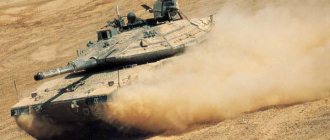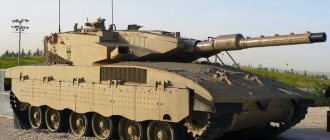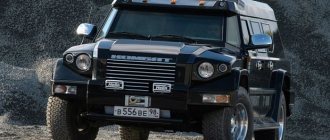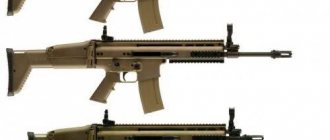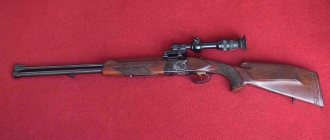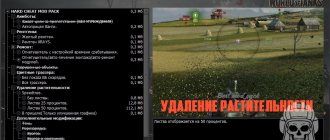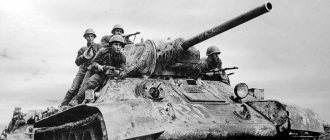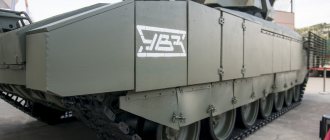Throughout its short history of independence, Israel has been forced to fight to defend its borders and defend against terrorist attacks. To survive, the Israelis had to pay great attention to the development of the armed forces and the military-industrial complex. Today, the Israeli Army (IDF) is one of the most advanced and combat-ready armed forces in the world, and the country’s military-industrial complex is considered no less advanced. In 2010, Israel exported $7.2 billion worth of military products, ranking fourth in the world. Only the USA, Russia and Germany had better results.
This is not surprising: almost all Israeli military developments are tested in real combat conditions. The country's military leadership pays great attention to the development of armored forces and the creation of new, more and more advanced models of armored vehicles.
For several decades now, the main IDF tank has been the Merkava; it was put into service in the late 70s of the last century. Merkavah is translated from Hebrew as “war chariot,” but the meaning of this word is somewhat deeper. It is found in Old Testament texts and denotes the chariot of God and at the same time his throne, drawn by fantastic animals.
Every year, the authoritative American analytical agency Forecast International releases a ranking of the best tanks in the world. In recent years, the Merkava almost always occupies a leading position in it, ahead of the German Leopard and the Russian T-90. In terms of its layout and some characteristics, the Merkava is a truly unique combat vehicle that has no analogues among modern battle tanks.
A special feature of the Merkava is its development for a specific theater of military operations and its “customization” for tactical techniques that are most often used by IDF tank crews. Since 1979, four modifications of the Merkava have been created: Mk.1, Mk.2, Mk.3 and Mk.4. Currently, work is underway to create the next modification of the tank, but, most likely, the Merkava-5 will be a new generation combat vehicle, unlike its predecessors.
History of creation
Development of the Merkava tank began in 1970 after the British refused to sell the Chieftain Mk 1 to the Israelis. Such a demarche came as a complete surprise to the country's leadership; a decision was made to create its own combat vehicle.
The developers were led not by an engineer, but by a professional tanker, Israel Tal, who went through the entire Second World War, stood at the origins of the creation of the IDF and took part in all the Arab-Israeli wars. This is a rather unusual situation for the world tank building industry. Tal is considered the founding father of Israeli armored forces.
After analyzing the Six-Day War and the Sinai Campaign, Tal came to the conclusion that all main battle tanks (MBT) existing at that time were not very suitable for the Israeli army. A new vehicle was needed, the characteristics of which would most closely correspond to the nature of the theater of military operations and the Israeli defense doctrine.
When creating a new tank, the main emphasis was on its firepower, maneuverability and, most importantly, on the protection of the crew. Even after the destruction of the vehicle, the tankers had to survive. Another important feature of Israel, which largely determined the appearance and characteristics of the Merkava, is the compactness of this country. The fact is that the dimensions and weight of tanks set the standards for rail transportation to the greatest extent. Israel created a combat vehicle to protect its own territory, where it is quite possible to use vehicle platforms for transportation. The designers had less stringent restrictions on the weight and dimensions of the vehicle being developed, which is why today the Merkava is one of the heaviest tanks.
The Merkava is not suitable for use in frosty conditions, tropical humidity or Russian off-road conditions. But it is perfectly adapted to the mountains and deserts of the Middle East. Such a narrow specialization practically negated the export potential of the tank, but the Israelis created it to protect their country.
The tactics of the Israeli armored forces involve shooting from well-prepared positions on the slopes of heights. When used in this way, the tank's turret is very vulnerable, so the developers tried to reduce its frontal projection and place most of the fighting compartment in the hull.
The first prototype of the Merkava was ready in 1971. At the beginning of 1979, the first production Merkava Mk.1 vehicles entered service. 250 units of this modification were produced. Since then, four generations of the combat vehicle have been created, and in each of them the designers have implemented ideas that were revolutionary for modern tank building.
see also
- Media files on Wikimedia Commons
The Israel Defense Forces also have other armored personnel carriers in service, created on tank chassis - “Namer” and “Puma”.
- Namer (Hebrew: leopard; abbreviated from Hebrew: נגמ"ש מרכבה [ Na
gmash
Merkava
] - Merkava armored personnel carrier) is an Israeli-made heavy armored personnel carrier. This armored personnel carrier is developed on the chassis of the Merkava Mk.4 tank and is an Israeli development. - Puma is an Israeli-made heavy engineering armored personnel carrier. This armored personnel carrier is designed on the hull of the Centurion Shot tank (the Israeli name for the English Centurion MBT) and the suspension of the Merkava Mk2 tank.
Other examples of similar equipment:
- BTR-T - Russian heavy armored personnel carrier
- BMP-55
Description of design
The main difference between the Merkava and other modern tanks is its layout: the engine and transmission are located in the front part of the hull, and the fighting compartment occupies the middle and rear parts. At the rear of the tank there is a landing compartment in which infantrymen, wounded soldiers, additional ammunition or a replacement crew can be transported. This unique design idea essentially turns the Merkava into a universal vehicle capable of performing the role of infantry fighting vehicles and armored personnel carriers.
Another non-standard solution is the design of the tank’s hull and turret – they are cast. The Merkava's armor has large angles of inclination, the engine compartment is shifted to the right side of the tank, and on the left there is a control compartment with a driver's seat. He has three observation devices (periscopes), but due to the shift of his workplace to the left, his view is severely limited.
An armored partition is installed between the engine and fighting compartments. The main fuel supply is located in the rear of the armored fender niches; in their front part there are air intakes.
The tank's turret has a wedge-shaped shape, which increases the number of ricochets when it hits its front part. The Merkava turret has spaced armor, with additional protection elements located between the two main walls. At the back of the tower is a basket.
The turret contains space for three crew members: the loader, the tank commander and the gunner. The loader's position is located to the left of the gun; if necessary, he can serve as a gunner or driver. The gunner's position is to the right of the gun; to perform his functions, he has an optical sight with a laser rangefinder and a ballistic computer. For a general overview there is a periscope observation device.
The commander's position is behind and slightly above the gunner. It has a panoramic optical sight, and in addition, the commander has access to the data received by the gunner. Based on them, he can give target designations or aim a weapon.
At the rear of the tank there is a compartment that can accommodate paratroopers (6 people), four stretchers with wounded or additional ammunition. The tactics of using the Merkava do not provide for the transportation of troops; usually the rear compartment is used for additional shells.
The Merkava Mk.1 is armed with a 105-mm M68 cannon, created in the USA and produced in Israel under license. The gun is stabilized in two planes and has a thermal casing. The ammunition load is 62 rounds. The gun is paired with a Belgian 7.62 mm MAG machine gun, produced under license. Two more machine guns (7.62 mm) are mounted on the roof of the turret. Above the gun barrel there is a 12.7 mm machine gun, which is controlled remotely. Also installed on the turret is a 60-mm mortar, its ammunition capacity is 30 min.
The engine is an American diesel AVDS-1790-5A with turbocharging, the transmission is CD-850-6B, also made in the USA, it has been modified by local specialists.
Spring suspension, Christie type. On each side there are six rubberized road wheels and five support rollers. The tracks are all-metal, their width is 640 mm.
Tank modifications
The Merkava Mk.1 took part in the Lebanon War of 1982; after its end, Israeli designers created the Merkava Mk.2 modification. It took into account the experience of the first combat use of the tank. The changes affected the vehicle's security, its maneuverability and increased firepower.
The turret's armor was strengthened with the help of additional screens with combined armor, and the side protection was similarly improved. The mortar was moved inside the turret, and now fire could be fired without leaving the vehicle. Baskets for various property were mounted on the tower, which provided additional protection. To protect against cumulative ammunition, balls on chains were hung from the tower.
The tank received a more advanced ballistic computer and range finder, and a little later a thermal imager was installed on it.
The weight of the Merkava Mk.2 increased to 65 tons.
"Merkava Mk.3". This modification received additional armor protection on the sides and turret, and a more powerful 120 mm MG251 smoothbore gun was installed on the tank. Ammunition was reduced to 46 rounds. Laser radiation sensors were installed on the Merkava Mk.3, which warned the crew about the danger of fire from guided missiles. This modification received the Matador-3 fire control system. The weight of the Merkava Mk.3 was 65 tons.
"Merkava Mk.4". It was put into service in 2004. It was equipped with a new diesel engine GD883 General Dynamics (USA) with a power of 1500 hp. With. and Renk RK 325 transmission (Germany) with five speeds.
The shape of the turret has changed significantly due to the new configuration of armor modules, and the gun has received a mantlet. The main armor was also strengthened, the loader lost his hatch, and the commander's hatch became so massive that it opens mechanically. The visibility for the driver was improved, he received a rear view camera. The mine protection of the bottom has become more reliable.
The tank commander received a new panoramic sight with a thermal imager, and the gunner's sight was installed on the roof. The tank was equipped with a new BIUS "Tsayad".
The Merkava Mk.4 was equipped with a new MG253 gun, which can withstand higher pressure of powder gases. An automatic loader has appeared in the turret niche, which can accommodate 10 shells. The rest of the ammunition is located in the rear of the tank.
After the 2006 Lebanon War, the Merkava Mk.4 was equipped with the Trophy active protection complex (KAZ). Combat vehicles equipped with KAZ received the designation “Merkava Mk.4M”. "Trophy" is designed to combat anti-tank missiles (ATGMs) and rocket-propelled grenades. The system consists of 4 radars; they detect ammunition approaching the vehicle and give the command to destroy it.
KAZ “Trophy” is the first such system that has been tested in real combat conditions.
During the last IDF combat operation in Lebanon, Hezbollah militants fired more than 1 thousand Russian-made ATGMs at Merkava Mk.4 tanks. Only 22 vehicles (mostly old modifications) were damaged, and 5 tanks were lost. That is, the effectiveness of modern Russian ATGMs against the Merkava was only 0.5%. Now an even more advanced KAZ Meil Ruach (“Air Cloak”) is being developed.
The cost of one Merkava Mk.4 tank is $3.7 million. KAZ "Trophy" adds approximately 10% to this amount.
IDF ARTILLERY PARK
The specific power of the Merkava-4—23 hp/t—is better than that of earlier versions of the tank. |
The basis of the artillery fleet of the Israel Defense Forces is the M109 self-propelled howitzer. More than 600 M109 self-propelled guns have been upgraded, first to the Rokhev variant. then to Doher. In 2005, 140 M107 Romakh 175 mm caliber mounts, 36 203 mm M110 self-propelled guns, and 120 155 mm L-33 guns were also in service. Self-propelled artillery is complemented by towed artillery - about 460 barrels. There are another 190 self-propelled multiple launch rocket systems, most of them Soviet-made Arab trophies: the most advanced MLRS are the 48 American MLRS combat vehicles.
Evaluation of the combat vehicle and its future
OBS "Merkava" is, without a doubt, one of the best tanks of our time. It has certain disadvantages, caused primarily by its non-standard layout. Due to the location of the engine in the front of the vehicle, the nose of the tank is very heavy, which creates strong longitudinal vibrations of the hull when firing and reduces accuracy. The heat from the engine interferes with the operation of the sighting devices.
The current mass of the tank has reached 70 tons, which indicates the impossibility of further increasing the armor. The mass introduction of fire control systems on tanks has changed the statistics of hits, now more of them are on the hull. The Merkava has less protection than the turret.
However, the overall security of the Merkava, the ease of operation of the crew, and high firepower outweigh the above disadvantages. If an Israeli tank is damaged, its crew simply turns into infantry, and any serious defeat of Soviet tanks (Russian, Ukrainian) is almost guaranteed to lead to the death of the tank crews.
Specifications
| Crew | 4 people |
| Weight with ammunition | 65 tons |
| Tank length | 7 m 45 cm |
| Length with gun | 9 m 40 cm |
| Clearance | 53 cm |
| Width over tracks | 3 m 72 cm |
| Tower hatch height | 2 m 70 cm |
| CHARACTERISTICS IN MOVEMENT CONDITIONS | |
| Engine power, 12-cylinder, four-stroke, water-cooled, turbocharged diesel engine | 1500 l. With. |
| Diesel fuel tank life on the highway; capacity 1400 liters | 500 km |
| Highway speed | 65 km/h |
| Speed on arable land | 50 km/h |
| Obstacle elevation angle | 30 degrees |
| Obstacle barrier | 1m |
| Barrier ditch | 3m |
| Obstacle ford | 1 m 38 cm |
| COMBAT WEAPONS | |
| Gun type; caliber | Smoothbore caliber 120 mm |
| Gun ammunition | 10 shells in the machine gun + 36 shells + 14 emergency |
| FN MAG coaxial machine gun | 7.62 mm |
| Anti-aircraft machine gun | 7.62 mm |
| Mortar | 60 mm |
| PROTECTION AND DEFENSE | |
| Combined cast steel armor, active, dynamic protection. |
Notes
- D. Izyumov. Armored personnel carriers and armored vehicles of foreign countries // “Foreign Military Review”, No. 3 (768), 2011. pp. 43-49
- “BTR-reanimation” will replace “tank-bulences” // Newsru.co.il from December 18, 2005
- Armored personnel carrier Akhzarit (Russian). israelion. Access date: January 6, 2022.
- The exploded armored personnel carrier of the Golani brigade was 50 years old (Russian). MIGnews (20.2007). Access date: January 6, 2022.
- International Institute for Strategic Studies.
The Military Balance 2016 / James Hackett. - London: Taylor&Francis, 2016. - P. 334. - ISBN ISBN 9781857438352.
